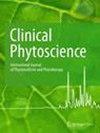生物测定指导下的(迷迭香)Rosmarinus officinalis 叶提取物抗糖尿病馏分的分离和化合物鉴定
引用次数: 0
摘要
糖尿病是一种以血糖长期升高为特征的代谢性疾病。它是人类常见的健康问题,死亡率和发病率都很高。迷迭香(Rosmarinus officinalis)等多种药用植物已被用于治疗糖尿病。大多数传统的抗糖尿病药物都有一些副作用,因此有必要探索抗糖尿病药物的新来源。本研究的目的是调查从 R. officinalis 中提取抗糖尿病化合物的可能性,这些化合物可作为药物研发的线索。将 R. officinalis 叶子用二氯甲烷中 50% 的甲醇浸泡,然后用柱层析法对粗提取物进行分馏。对得到的馏分进行体外α-淀粉酶抑制试验。在糖尿病诱导的 Wistar 大鼠身上评估了这些馏分的抗高血糖潜力。采用气相色谱-质谱联用仪(GC-MS)分析了最有效的馏分,以鉴定化合物。共有 21 个色谱馏分具有不同的α-淀粉酶抑制活性。其中 11 个馏分的α-淀粉酶抑制活性超过 30%。乙酸乙酯馏分具有最高的抑制潜力(半数致死浓度为 2.8 μg/mL)。大鼠抗糖尿病试验表明,馏分(F1)和(F4)的血糖降低率最高,分别为 44.5 ± 0.4% 和 52.8 ± 1.3%(p < 0.05)。馏分 F1 和 F4 的气相色谱-质谱分析表明,F1 和 23 中分别含有 21 和 23 种化合物。本研究表明,从 50%甲醇和二氯甲烷中提取的 R. officinalis 粗萃取物馏分具有抑制α-淀粉酶和抗高血糖活性,并含有不同化学结构的次生代谢物。正己烷和正己烷/乙酸乙酯(8/2)馏分对α-淀粉酶的抑制作用最强,同时具有很高的抗高血糖活性,这为获得新型抗糖尿病药物的先导化合物提供了希望。本文章由计算机程序翻译,如有差异,请以英文原文为准。
Bioassay guided isolation and compounds identification of the anti-diabetic fractions of (rosemary) Rosmarinus officinalis leaves extract
Diabetes mellitus is a metabolic disease characterized by prolonged elevated blood glucose levels. It is a common health problem with a high mortality and morbidity to the human race. A number of medicinal plants such as rosemary (Rosmarinus officinalis) have been used for the treatment of diabetes. Most of the anti-diabetic conventional drugs have been found to have some side effects and there is therefore need to explore new sources of anti-diabetic drugs. The aim of the current study was to investigate the possibility of getting anti-diabetic compounds from R. officinalis that can be used as leads for drug discovery. R. officinalis leaves were macerated in 50% methanol in dichloromethane and the crude extract fractionated by column chromatography. The obtained fractions were subjected to an in-vitro alpha-amylase inhibition assay. The anti-hyperglycemic potential of the fractions was evaluated in diabetic induced Wistar rats. The most potent fractions were analyzed by gas chromatography-mass spectrophotometry (GC-MS) for identification of the compounds. A total of 21 chromatographic fractions were assembled with different alpha- amylase inhibition activity. Eleven of the fractions had more than 30% alpha-amylase inhibition activity. The ethyl acetate fraction had the highest inhibition potential (LC50 of 2.8 μg/mL). The anti-diabetic assay in rats showed that fractions (F1) and (F4) had highest blood glucose reduction of 44.5 ± 0.4 and 52.8 ± 1.3%, respectively (p < 0.05). GC-MS analysis of fractions F1 and F4 showed the presence of 21 and 23 compounds in F1 and 23, respectively. This study has demonstrated that R. officinalis crude extract fractions obtained from 50% methanol in dichloromethane possesses alpha-amylase inhibitory and anti-hyperglycemic activities as well as secondary metabolites with varying chemical structures. The hexane and hexane/ethyl acetate (8/2) fractions showed most potent alpha-amylase inhibition with high anti-hyperglycemic activity giving hope of a possibility of obtaining lead compounds for new anti-diabetic drugs.
求助全文
通过发布文献求助,成功后即可免费获取论文全文。
去求助
来源期刊
自引率
0.00%
发文量
18
审稿时长
13 weeks
期刊介绍:
Clinical Phytoscience is an international, peer-reviewed, interdisciplinary, and open access journal publishing high quality research articles on clinical evidence and use of medicinal plants in the development of efficient and well tolerated phytotherapy. Clinical Phytoscience focuses on phytotherapy, looking at proof of concept, efficacy and safety, to be established “at eye level” compared to pharmacotherapy. The emphasis lies on application oriented topics (efficacy and safety of phytotherapy in a specific indication, including its need and acceptance by the patient). The scientific results published in the journal should contribute to the recovery and maintenance of human health by phytotherapy. Clinical Phytoscience will publish high-quality evidence-based clinical studies and relevant pharmacological studies. Key areas of interest are: -Upper and lower airways, ENT and pneumology -Gynecology -Urology -Nephrology Pediatrics -Intestinal tract -Hepatology -Diabetes/metabolic Syndrome -Immunology and microbiology -Hygiene -Analytics

 求助内容:
求助内容: 应助结果提醒方式:
应助结果提醒方式:


